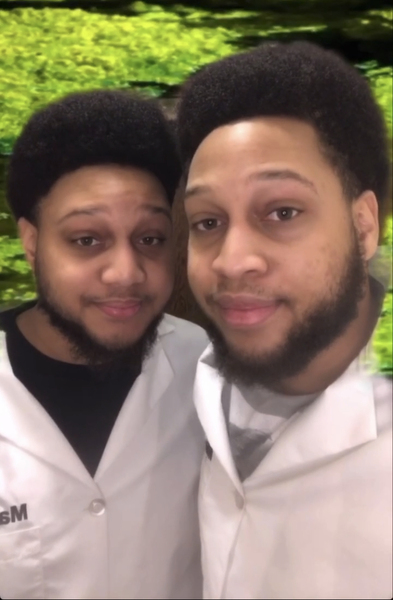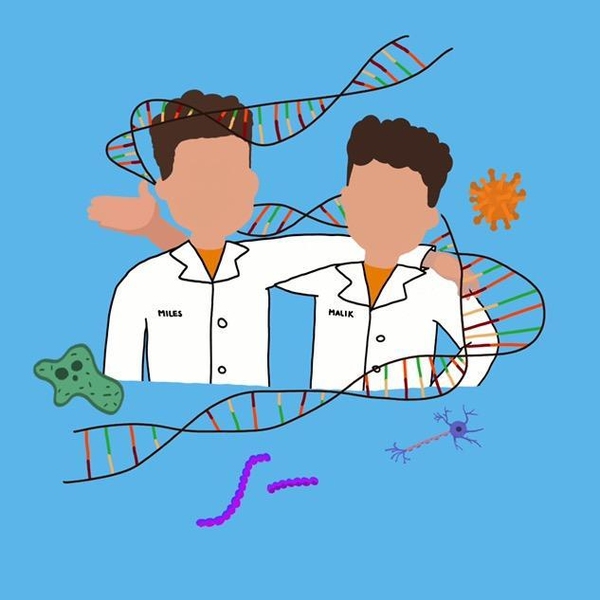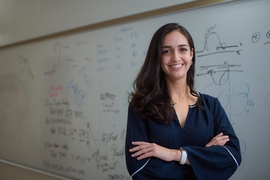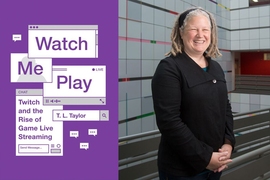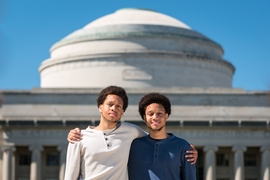On Jan. 20, MIT juniors and fraternal twins Malik and Miles George uploaded their first science video to their new TikTok account, @malikandmiles. The video, a short joke about the complexity of the Krebs Cycle, got 83 likes. The two pondered if they would join the ranks of popular science media personalities like Hank Green and Bill Nye. Now, more than a month later, they’ve posted more than 100 videos on a variety of science topics including genetics, photosynthesis, Covid-19 vaccines, and physics.
They’ve also amassed nearly 50,000 followers.
Their community of fans range from middle schoolers to professional scientists, and the brothers often field questions about attending MIT, applying to colleges, and being Black in STEM. In most of their videos, the brothers sport white lab coats embroidered with their names.
Malik and Miles graduated as co-valedictorians from their high school in Woodbridge, New Jersey, before matriculating together to MIT, where they are both majoring in biological engineering and minoring in African and African diaspora studies. Now, seeing the success of their new social media account, they have big plans for what to do next: launching a STEM education and outreach initiative, offering fun, immersive remote programming for students of all ages.
It’s the start of a dream come true for the duo. Miles says that “in the back of our minds, Malik and I, when we got older, we always wanted to be science educators, public speakers for the sciences.”
Trying TikTok
When social distancing guidelines went into effect in early spring 2020, the George brothers first downloaded TikTok. Around that time, the app, which allows users to post 60-second or shorter videos to a variety of audios and songs, was surging in popularity. TikTok now has approximately 100 million active monthly users in the United States, a figure eight times what it was at the beginning of 2018.
Out of boredom and curiosity, the George twins started posting dances and memes. Their videos quickly gained traction, and that initial account gained almost 200,000 followers by the end of August. But they wanted to do more.
“It didn’t have a sense of community,” Miles says of the twins’ first account. “It was just growth without purpose. We didn't necessarily like a lot of the content we were making.”
With school picking back up for the fall semester, they stepped away from their account. Then, during the January 2021 Independent Activities Period, they decided to relaunch a new account all about making STEM accessible and interesting to all audiences.
To get ideas for videos, the brothers look through the app’s “Discover” page. From there, they can see which hashtags and audios are trending. Then, they apply a science spin on the new trends.
Many social media platforms open by showing a user recent posts by their friends or accounts they follow. TikTok is different. When a user opens the app, they immediately see a “For You” page, a collection of videos curated based on the user’s likes and interests from accounts all over the world. Users simply scroll to see more videos curated for them.
“Whether it's doing trending dances with STEM memes or comedic skits acting as cells, we're getting a better rhythm of how to integrate comedy, TikTok trends, and science into our videos,” Malik says.
In one of their most popular videos, posted on Feb. 8, Malik hands Miles a pepper shaker. Miles shakes a bit onto a bowl of water. The pepper flakes distribute evenly across the surface of the water, but do not dissolve –– Miles explains that pepper is hydrophobic. Then, he places a drop of soap in the center, and the flakes of pepper fling out to the bowl’s edges. Miles explains that soap is a surfactant, which reduces a liquid’s surface tension. A popular TikTok song plays as background music. The video has nearly 53,000 views.
Their content isn’t all fun tips and tricks. The two have also produced more serious content encouraging viewers to wear masks and sign up to receive the Covid-19 vaccine when eligible.
“We dedicate a lot of our content not only to Covid-19, but also just general misconceptions that are popular, especially biology topics in the news, just because they're very important,” Malik says. “They relate to human health, but they're also very difficult, I think, for the public to understand. There’s a lot of misconceptions, and sometimes fear can arise from these topics.”
Building community
Almost every night, the two host a livestream on TikTok for several hours. They call it “M&M Office Hours.” During the livestream, followers can message questions that the brothers see and answer in real-time, and followers can chat among themselves. The duo also set up a social channel available to all of their fans on Discord, an online community platform.
“There's high schoolers and middle schoolers, and they ask questions about applying to college,” Miles says. “And then on the other side, you have postdocs and grad students who can share their experiences. So it's a really wide range group all centered around STEM, which is a really nice community that we didn't think we could have on social media.”
Recently, a fifth-grade teacher saw a video of theirs and commented that her students would love their content. So they replied to her, offering to talk to her students remotely –– and she took them up on the offer.
“At that moment, the course of our TikTok expanded,” Miles says. “We are in the process of opening up a STEM advocacy initiative, where we talk to K-12 schools about STEM, college, and diversity.”
In early March, they instructed a class of fifth-grade students on how to make slime. They built a lesson plan about non-Newtonian fluids, which can behave as either liquids or solids depending on how they are treated
Their goal, on TikTok and off, is to encourage young, diverse students to pursue careers in STEM. “We hope that if young Black children see two Black students in college doing science, it might inspire them for the future,” Miles says.
“One of my favorite developments is that we've gotten in contact with our old high school principal, and we're actually going to be doing bi-weekly meetings with our high school where we will be speaking to different grades there,” Malik says. “We’ll be talking about our own path at the school, and how they can best prepare to go to college, knowing what their experience is like directly.”
They’ve already had a handful of other teachers reach out to them on the platform to set up speaking or teaching engagements.
“I think our account helps to humanize the experience at MIT,” Malik says. “It lets people know that at MIT, we have fun, we joke about things. In terms of diversity, which we also are passionate about, we think it helps for people to know that there are also people that look like us at schools like ours.”
